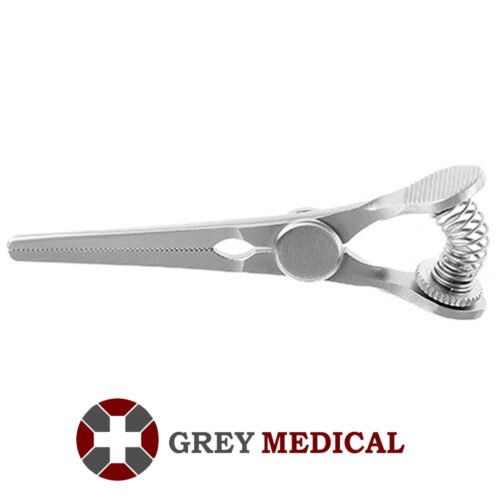The Jacobson clamp is a vital tool in the realm of surgery, particularly in delicate procedures requiring precision and control. Recognized for its reliability and functionality, the Jacobson clamp is indispensable in surgeries where bleeding needs to be meticulously controlled, and access to narrow, hard-to-reach areas is essential. Commonly used in the field of ear, nose, and throat (ENT) surgeries, this instrument provides surgeons with the ability to perform intricate procedures safely and efficiently. Whether it’s controlling blood vessels or securing tissue, the Jacobson clamp is an essential part of the surgical toolkit.
The Unique Design of the Jacobson Clamp
One of the key features that make the Jacobson clamp a popular tool in surgical practice is its design. The clamp consists of two long, slender arms connected by a central handle, with serrated tips that help secure tissue or blood vessels. The design is particularly suited to accessing and working within confined spaces, such as the nasal cavity or the throat. Its narrow and lightweight form gives the surgeon greater maneuverability, making it easier to handle in delicate surgical environments where precision is crucial.
The clamp’s locking mechanism is another feature that adds to its versatility. The locking function ensures that the clamp can hold tissue or vessels securely without the need for constant pressure from the surgeon’s hands. This allows the surgeon to focus on other aspects of the procedure, such as dissection or suturing, without worrying about the clamp slipping or losing its grip. The ability to hold tissue in place with minimal effort is particularly important in surgeries where fine control is required.
Functionality in Controlling Bleeding
One of the primary applications of the Jacobson clamp is in controlling bleeding during surgery. Surgeons often use this clamp to occlude blood vessels, thereby preventing excessive blood loss and maintaining a clear surgical field. In ENT surgeries, for example, small blood vessels are common and can be difficult to manage due to their size and location. The Jacobson clamp allows the surgeon to isolate these vessels and control blood flow, improving visibility and reducing the risks associated with uncontrolled bleeding.
By clamping blood vessels, the Jacobson clamp allows the surgical team to continue working without the distraction or danger of excess blood. This contributes to a more efficient operation and can minimize the need for additional interventions or longer surgical times. This ability to manage bleeding effectively is critical in ensuring the safety and success of surgeries, particularly those that involve delicate or high-risk areas.
Versatility Across Surgical Disciplines
Although the Jacobson clamp is most commonly associated with ENT procedures, its versatility extends beyond that. Surgeons in other specialties, such as vascular surgery and neurosurgery, also make use of this instrument for its ability to manage small vessels and delicate tissue structures. The clamp is often used in areas where access is limited and control over bleeding is vital. Its narrow profile makes it suitable for use in deep or confined spaces, allowing surgeons to work in areas where larger, more conventional clamps would be ineffective.
In vascular surgeries, for example, the Jacobson clamp is often used to temporarily occlude blood flow to prevent hemorrhaging or to isolate blood vessels for further treatment. In neurosurgery, it can be used to control blood flow in areas around the brain or spinal cord, where precision is paramount. Its adaptability and effectiveness in a wide range of surgical specialties make it a tool of choice for many experienced surgeons.
The Role of the Jacobson Clamp in Improving Surgical Outcomes
The use of the Jacobson clamp can significantly enhance the overall outcome of a surgery. By providing precise control over bleeding, ensuring clear visibility, and improving the surgeon’s ability to work with small and delicate tissues, this instrument helps reduce the risks of complications and promotes a smoother recovery for patients. Surgeons rely on this tool to enhance their ability to perform even the most challenging procedures with confidence and accuracy.
In addition, the Jacobson clamp’s design helps reduce surgeon fatigue. Its lightweight construction and easy-to-handle locking mechanism allow the surgeon to maintain control throughout the procedure without straining their hands or wrists. This ergonomic design helps improve efficiency in the operating room, ultimately contributing to better surgical outcomes and reducing the risk of errors.
Conclusion: A Staple in the Surgical Toolkit
The Jacobson clamp is a key instrument in the operating room, offering a combination of precision, versatility, and control that is essential in a wide variety of surgeries. From its ergonomic design to its ability to manage bleeding effectively, it is a tool that continues to serve surgeons across multiple specialties. Whether used in ENT surgeries, vascular procedures, or neurosurgery, the Jacobson clamp remains a cornerstone of surgical practice, ensuring better outcomes and safer procedures for patients. Its significance in the operating room cannot be overstated, as it continues to be a trusted instrument in the hands of skilled surgeons.





Comments